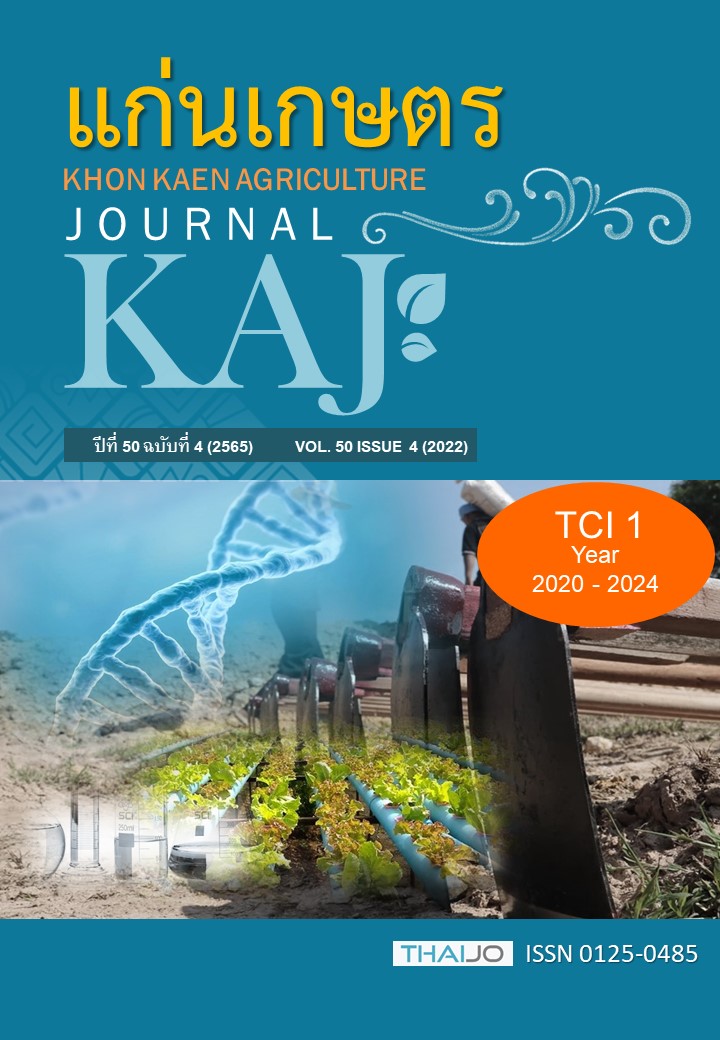การระบุชนิดของเชื้อราสาเหตุโรคผลเน่าของมะม่วงน้ำดอกไม้สีทองเพื่อการส่งออก
Main Article Content
บทคัดย่อ
มะม่วงน้ำดอกไม้สีทองเป็นผลไม้เศรษฐกิจที่สำคัญของประเทศไทย ปัญหาหลักในการผลิตมะม่วงเพื่อการส่งออกเกิดจากโรคผลเน่าหลังการเก็บเกี่ยว จึงได้ทำการเก็บตัวอย่างโรคผลเน่าของมะม่วงน้ำดอกไม้สีทองเพื่อการส่งออกจากอำเภอบ้านแฮด จังหวัดขอนแก่น นำตัวอย่างโรคจำนวน 30 ตัวอย่าง มาแยกเชื้อโดยวิธี tissue transplanting แยกได้เชื้อราจำนวน 20 ไอโซเลต เมื่อทำการทดสอบความสามารถในการเกิดโรคพบว่า ทุกไอโซเลตทำให้การเกิดโรคบนผลมะม่วงน้ำดอกไม้สีทอง และไอโซเลต NDM8 มีความรุนแรงในการก่อโรคสูงที่สุด มีขนาดแผลบนผลมะม่วงเท่ากับ 100.73 มม. คัดเลือกเชื้อราสาเหตุโรคจำนวน 11 ไอโซเลต เพื่อระบุชนิด (species) โดยอาศัยลักษณะทางสัณฐานวิทยาและเทคนิคชีวโมเลกุล ทำการเพิ่มปริมาณดีเอ็นเอในส่วน internal transcribe spacer ของ rDNA (ITS1-5.8S-ITS2) และบริเวณ translation elongation factor 1-alpha (EF1-α) gene ด้วยเทคนิค PCR ทำการระบุชนิดของเชื้อราสาเหตุโรคผลเน่าได้ 5 ชนิด ได้แก่ Lasiodiplodia theobromae (NDM5, NDM7, NDM8, NDM17, NDM19, NDM20), Lasiodiplodia pseudotheobromae (NDM16, NDM18), Botryosphaeria dothidea (NDM10), Colletotrichum gloeosporioides (NDM12) และ Diaporthe pascoei (NDM13) ผลการศึกษาที่ได้ในครั้งนี้ สามารถนำไปประยุกต์ใช้เป็นแนวทางในการควบคุมโรคผลเน่าของมะม่วงน้ำดอกไม้สีทองให้มีประสิทธิภาพในระดับแปลงปลูกได้
Article Details

อนุญาตภายใต้เงื่อนไข Creative Commons Attribution-NonCommercial-NoDerivatives 4.0 International License.
เอกสารอ้างอิง
ชัยณรงค์ รัตนกรีฑากุล และพิมพ์รัมภา เปี่ยมสกุล. 2557. ความหลากหลายในการใช้ข้อมูลดีเอ็นเอของเชื้อรา Lasiodiplodia sp. เพื่อการจำแนกเชื้อ. วารสารวิทยาศาสตร์เกษตร. 45(พิเศษ 3/1): 157-160.
สุวิตา แสไพศาล, ศุภศิริ เชวงเผ่าพันธุ์ และชเนรินทร์ ฟ้าแลบ. 2563. การระบุชนิดเชื้อราสาเหตุโรคผลเน่าของมะม่วงเขียวเสวยในพื้นที่การผลิตจังหวัดเลยเพื่อการส่งออก. วารสารแก่นเกษตร. 48(6): 1360-1373.
สำนักงานเศรษฐกิจการเกษตร กระทรวงเกษตรและสหกรณ์. 2563. สถิตินำเข้าส่งออก. แหล่งข้อมูล: http://www.oae.go.th/oae_report/export _import/export_result.php. ค้นเมื่อ 22 กรกฎาคม 2563.
Abdollahzadeh, J., A. Javadi, E.M. Goltapeh, R. Zare, and A.J.L. Phillips. 2010. Phylogeny and morphology of four new species of Lasiodiplodia from Iran. Persoonia. 25: 1–10.
Alves, A., P.W. Crous, A. Correia, and A.J.L. Phillips. 2008. Morphological and molecular data reveal cryptic speciation in Lasiodiplodia theobromae. Fungal Diversity. 28: 1-13.
Alivindia, D.G., and A.A. Miriam. 2015. Crop Protection 67 96e101 Contents. Crop Protection. 67: 96-101.
Choi, I.Y., J.H. Joa, S.W. Cho, W.H. Lee, V. Galea, and H.D. Shin. 2017. Occurrence of stem and shoot cankers caused by Phomopsis fukushii on mango. Australasian Plant Disease Notes. 12(1): 1-4.
de Oliveira Costa, V.S., S.J. Michereff, R.B. Martins, C.A.T. Gava, E.S.G. Mizubuti, and M.P.S. Câmara. 2010. Species of Botryosphaeriaceae associated on mango in Brazil. European Journal of Plant Pathology. 127(4): 509–519.
Kimura, M. 1980. A simple method for estimating evolutionary rate of base substitutions through comparative studies of nucleotide sequences. Journal of Molecular Evolution. 16: 111-120.
Li Q., S.G.S. Solangi, L. Tang, T. Guo, and S. Huang. 2018. Identification and characterization of Colletotrichum species associated with mango anthracnose in Guangxi, China. Plant Disease. 102(7): 480-489.
Lim, L., M.H. Mohd, and L. Zakaria. 2019. Identification and pathogenicity of Diaporthe species associated with stem-end rot of mango (Mangifera indica L.). European Journal Plant Pathology. 155(2): 687-696.
López, B.A., J.A. Ragazzo-Sánchez, R. Allende- Molar, G.D. Avila-Quezada, and M. Cal-deron-Santoyo. 2015. Colletotrichum gloeosporioides from mango Ataulfo: morphological, physiological, genetic and pathogenic aspects. Journal of Research in Biology. 5: 1641-1647.
Marques, M.W., N.B. Lima, M.A. de Morais Jr, S.J. Michereff, A.J.L. Phillips, and M.P.S. Câmara. 2013. Botryosphaeria, Neofusicoccum, Neoscytalidium and Pseudofusicoccum species associated with mango in Brazil. Fungal Diversity. 61: 195–208.
Ni, H.F., H.R. Yang, R.S. Chen, R.F. Liou, and T.H. Hung. 2012. New Botryosphaeriaceae fruit rot of mango in Taiwan: identification and pathogenicity. Botanical Studies. 53(4): 467-478.
Phillips, A.J.L., A. Alves, A. Correia, and J. Luque. 2005. Two new species of Botryosphaeria with brown, 1-septate ascospores and Dothiorella anamorphs. Mycologia. 97: 513-529.
Ragazzo-Sánchez, J. A., T. Coria, J.A. Ramírez de León, R.I Ortíz-Basurto, H. Cabanillas-Beltrán, and M. Calderon-Santoyo. 2015. Control of anthracnose in mango (Mangifera indica L.) var. ataulfo by high hydrostatic pressure combined with moderated temperature and the biocontrol agent candidat famata. Sylwan. 159: 448-460.
Slippers, B., G.I. Johnson, P.W. Crous, T.A. Coutinho, B.D. Wingfield, and M.J. Wingfiel. 2005. Phylogenetic and morphological re-evaluation of the Botryosphaeria species causing diseases of Mangifera indica. Mycologia. 97(1): 99–110.
Swamy, J.S. 2012. Anthracnose- A devastating pre and post-harvest disease in mango. Internat. Journal of Plant Protection Research. 5: 429-437.
Tan, Y.P., J. Edwards, K.R.E. Grice, and R.G. Shivas. 2013. Molecular phylogenetic analysis reveals six new species of Diaporthe from Australia. Fungal Diversity. 61(1): 251-260.
Tamura, K., G. Stecher, D. Peterson, A. Filipski, and S. Kumar. 2013. MEGA6: Molecular evolutionary genetics analysis version 6.0 Molecular Biology and Evolution. 30: 2725-2729.
Trakunyingcharoen, T., R. Cheewangkoon, C. To-anun, P.W. Crous, J.M. van Niekerk, and L. Lombard. 2014. Botryosphaeriaceae associated with diseases of mango (Mangifera indica). Australasian Plant Pathology. 43: 425-438.
Trakunyingcharoen, T., L. Lombard, J.Z. Groenewald, R. Cheewangkoon, C. To-anun, and P.W. Crous. 2015. Caulicolous Botryosphaeriales from Thailand. Persoonia. 34: 87-99.
Thompson, J.D., D.G. Higgins, and T.J. Gibson. 1994. Clustal W: Improving the sensitivity of progressive multiple sequence alignment through sequence weighting, position-specific gap penalties and weight matrix choice. Nucleic Acids Research. 22: 4673-4680.
White, T.J., T. Bruns, S. Lee, and J. Taylor. 1990. Amplification and direct sequencing of fungal ribosomal DNA for phylogenetics, p. 315-322. In M.A. Innes, D.H. Gelfand, J.J. Sninsky, and T.J. White (ed.) PCR protocols: a guide to methods and applications. Academic Press, Inc., San Diego, Calif.


